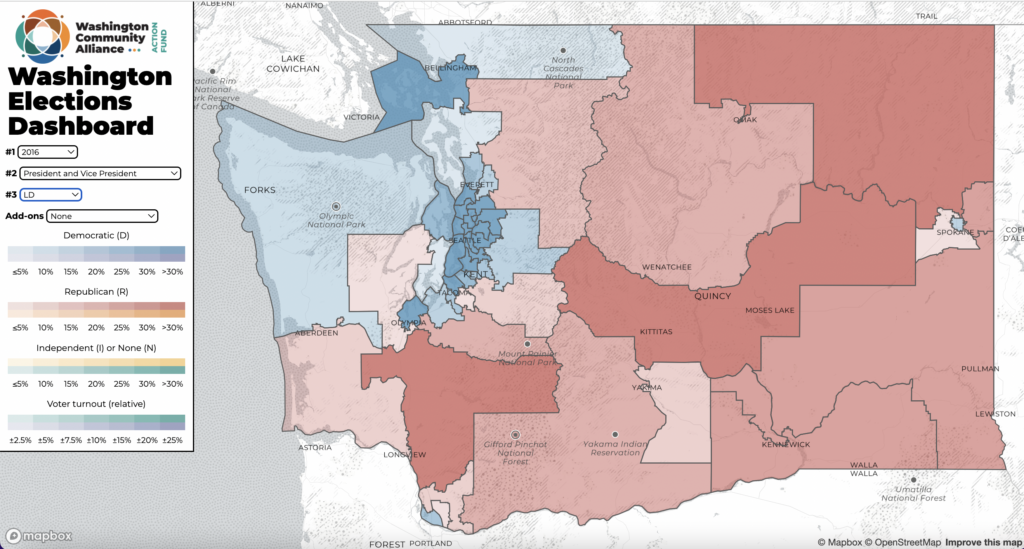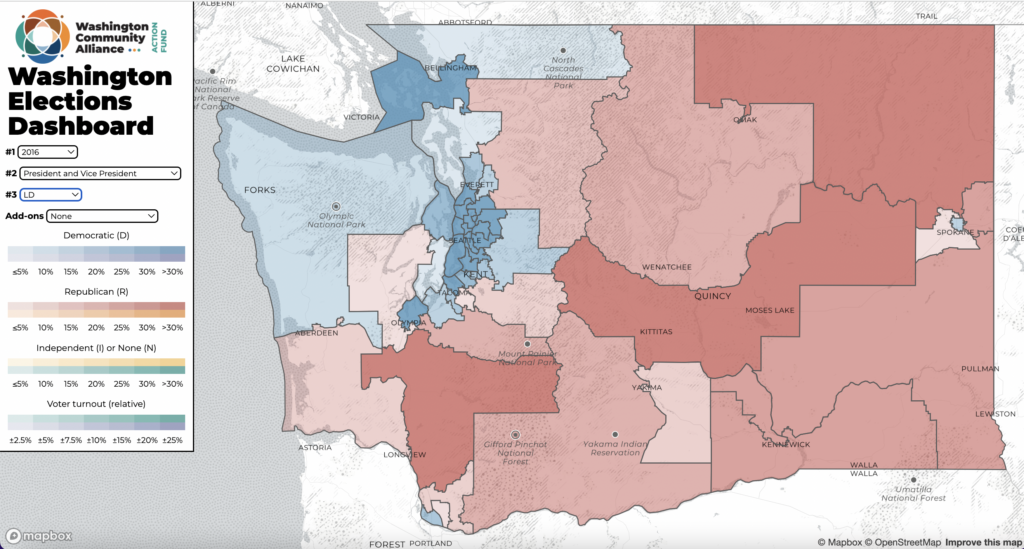
We see state legislature election results on a legislative district level all the time, but we rarely see how other candidates—for instance, candidates running statewide—perform at the state legislative district level. These data insights are important for many reasons. One being that they can show historically-safe (red or blue) legislative districts (LD) that are becoming more competitive. If a party doesn’t even contest a legislative race in a district for years at a time (which Democrats frequently do), there’s no way of knowing whether a districts’ voters are becoming more progressive (or conservative). On the other hand, statewide races like for Governor nearly always have competitive candidates from both parties, and they run in every district every four years. Perhaps even more importantly, top-ticket statewide races have predicted the direction an LD will flip in the next legislative cycle. The ability to harness this data, especially over time, can help identify new swing districts and pickup opportunities for parties.
Unfortunately, statewide race results by LD are hard to obtain—the Secretary of State’s website only breaks down statewide races like US Senate or President by county levels, not state LD levels. But we, at the Washington Community Alliance (WCA) have built a tool that automatically can break down statewide races down to an LD, congressional district, and even neighborhood level. We did an analysis of competitive statewide races with data broken down by the legislative district to find the districts that are politically changing the most, and emerging swing districts.
Past results predicted the future
From our data, we’re able to see how presidential results filtered by LD were able to predict drastic changes in two specific districts in the last decade: the 5th and 19th LDs. The white, working class 19th LD in Southwestern Washington with the cities of Longview and Aberdeen was once considered a Democratic stronghold with its labor union roots. The 19th voted twice for Obama and elected three Democrats to the Legislature for years. In 2016, it still sent two Democrats to the Legislature and only elected its first Republican in over a decade by less than 1%. However, Donald Trump carried the district for Republicans for the first time in several presidential elections, beating Hillary Clinton by 9%. Four years later, both state representatives and the senator from the 19th LD were all Republicans.

 In 2022, Republicans now carry this ancestrally-Democratic district by over 20%. Looking at state legislative results in 2016—and even in 2018 where Democrats nearly flipped back the seat GOP Rep. Jim Walsh narrowly won in 2016—one would have not predicted the magnitude to which the 19th LD has become a safely-Republican seat. But presidential elections disaggregated to the LD level showed the rightward shift the 19th LD would see down-ballot just once cycle later.
In 2022, Republicans now carry this ancestrally-Democratic district by over 20%. Looking at state legislative results in 2016—and even in 2018 where Democrats nearly flipped back the seat GOP Rep. Jim Walsh narrowly won in 2016—one would have not predicted the magnitude to which the 19th LD has become a safely-Republican seat. But presidential elections disaggregated to the LD level showed the rightward shift the 19th LD would see down-ballot just once cycle later.
In the 5th LD east of Seattle, with the cities of Issaquah and Carnation,, presidential results by LD also foreshadowed state legislative partisan shifts that state legislative results did not. These longtime conservative Eastside suburbs had voted in Republican state legislators for years—save conservative Democrat Sen. Mark Mullet. However in 2016, Democrat Hillary Clinton won the 5th LD by double digits while Democrats failed to flip any state house seats in the same district. Two years later, Democratic Reps. Lisa Callan and Bill Ramos would flip the district’s delegation to all Democratic, and win re-election by over 20% in 2020. Both the 19th and 5th districts reflect the accuracy of federal and statewide races to predict down-ballot trends on an LD level.
What lies ahead for Democrats?
Looking into the future, statewide results from the 2022 US Senate race show the 17th and 18th LDs of the Vancouver suburbs and perhaps further in the future, the 12th LD spanning Monroe to Wenatchee, as typically Republican districts down-ballot that are becoming more purple over time. Despite a Republican-favoring midterm year, Democratic Senator Patty Murray nearly flipped the ancestrally-Republican 17th and 18th LDs in exurban Southwestern Washington, losing by less than 2%. Local Democrats performed worse, but if the trend of top-ticket success foreshadowing down-ballot shifts holds, these are two districts that Democrats may be keen on investing in the next couple of election cycles.
 The WCA Election Dashboard offers everyday people a powerful tool to see how different districts and neighborhoods vote on many levels. The ability to analyze top-ticket elections by LD can predict political headwinds, and enable the progressive community to make better investments in money, time, and people into the races that will matter most.
The WCA Election Dashboard offers everyday people a powerful tool to see how different districts and neighborhoods vote on many levels. The ability to analyze top-ticket elections by LD can predict political headwinds, and enable the progressive community to make better investments in money, time, and people into the races that will matter most.
—
Andrew Hong

